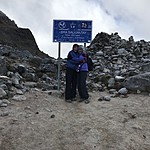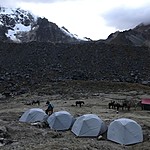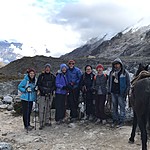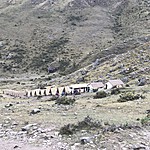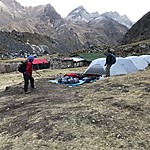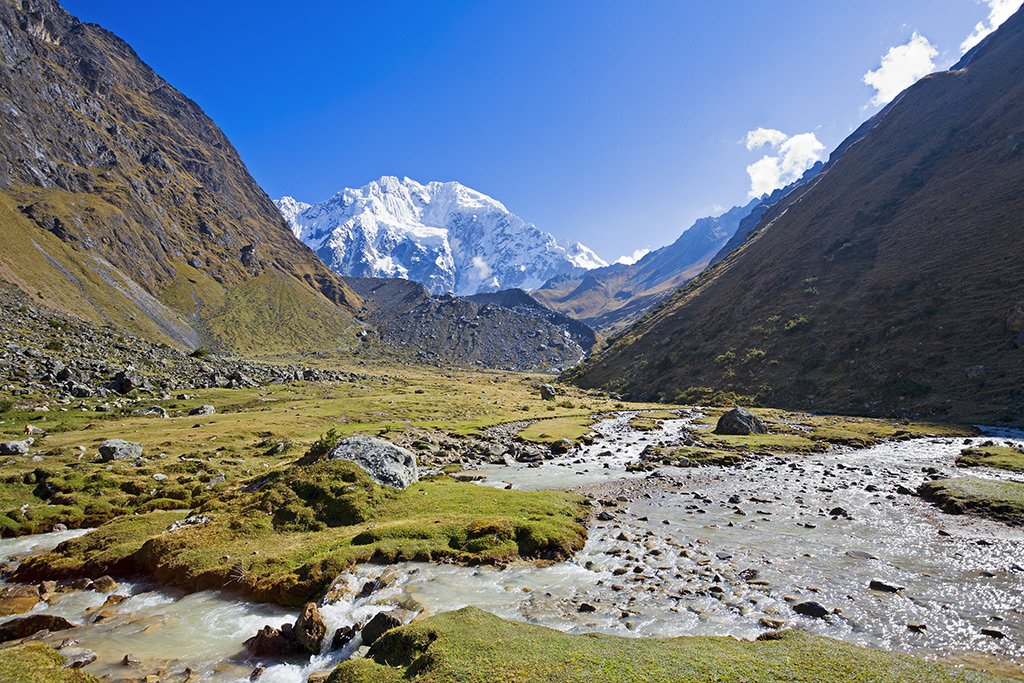
Salkantay Trek to Machu Picchu

Note: The 5-day group departures listed above include the Salkantay Trek and Machu Picchu portions of the itinerary below (days 3-7). Our specialists can help you plan the rest of the trip around your chosen departure date.
Ready to go on the Salkantay Trek? Get in touch with a trusted local travel specialist now.
Highlights
- Dip your feet in the beautiful glacial lake of Humantay
- Enjoy the comfort of cabins and lodges along the way, built and run by locals
- Cross over the 4660m Salkantay pass before descending into the cloud forest
- Harvest, roast and enjoy your own coffee from a local coffee farm
- Visit the lesser-known picturesque ruins of Llactapata
- Explore the fabled sanctuary of Machu Picchu
- Relax and enjoy the views on the train ride back from Machu Picchu
Overview
| Trek fast facts | |
|---|---|
| Trek Min. duration | 4 days |
| Max. elevation | 4660m |
| Start/finish | Cusco/Cusco |
| Difficulty | Moderate |
| Trek style | Cabins |
| Best season | May-October |
Salkantay, a 6272 m. peak in the heart of the Cusco region, is one of the most beautiful mountains in the Andes and one of Peru’s best and well-known treks. Over the course of five days, you’ll trek by a beautiful glacial lake, up and over the Salkantay pass (4660m), and descend down into the dense vegetation of the Peruvian cloud forest.
From there, you’ll trek to a local coffee farm where you can pick, harvest, roast and grind your own coffee, before joining paths with the famous Inca trail to Llactapata for views of Machu Picchu that few tourists get to see.
Finally, celebrate with a local meal at one of the best restaurants in Aguas Calientes before waking early for the final day where you get to tour the famous Inca citadel of Machu Picchu!
Brief itinerary
| Day | Activity | Altitude | Duration | Overnight |
|---|---|---|---|---|
| Day 1 | Arrival in Lima | 1550m | -- | Lima |
| Day 2 | Arrival in Cusco, Exploring the City | 3300m | -- | Cusco |
| Day 3 | Salkantay Trek Day 1/4: Glacial Lake Hike | 3851m | 3-4 hours | Soray Pampa |
| Day 4 | Salkantay Trek Day 2/4: Salkantay Pass | 2900m | 9 hours | Chaulley |
| Day 5 | Salkantay Trek Day 3/4: Organic Coffee Fields | 1950m | 5 hours | La Playa |
| Day 6 | Salkantay Trek Day 4/4: Llactapata Inca Trail | 2100m | 4-5 hours | Aguas Calientes |
| Day 7 | Tour of Machu Picchu | 3340m/2847m | 4-5 hours | Cusco |
| Day 8 | Depart Peru | 3300m | -- |
Chat with a local specialist who can help organize your trip.
Detailed itinerary
Day 1: Arrival in Lima

¡Bienvenidos! Welcome to Lima, Peru's largest city and central metropolitan hub, and home to one-third of the country's population. Located at the site of a pre-Columbian indigenous Ychsma settlement, which was conquered by the Inca empire in the 15th century and later by the Spanish conquistadores, Lima has a fascinating history and a diverse mix of cultures. Amerindian, European, Afro-Peruvian, and Asian—especially Chinese and Japanese—influences make Lima a dynamic and exciting city to explore.
Lima's breezy location on the Pacific Ocean and mild desert climate make it the perfect city for exploring on foot. Head downtown to mingle with locals, stretch your legs, and grab a bite to eat in one of the many award-winning restaurants.
Suggested activities include:
-
Explore the historic center of Lima, a UNESCO World Heritage Site packed with fascinating Spanish architecture. Start with a scenic tour of the colonial downtown, which emanates from the main square. Stroll over to the 16th-century Cathedral, which took 80 years to construct and was built in the grandiose style of the Spanish Empire.
-
Visit the Casa Aliaga, a colonial mansion granted by chief conquistador Francisco Pizarro to Jerónimo de Aliaga, one of his captains, in 1535. This is the only house from that era that still belongs to the same family.
-
Stroll around the Pueblo Libre district to the privately owned Larco Museum of pre-Columbian art, housed in a beautifully restored viceregal mansion built over a 7th-century pre-Columbian pyramid. The museum boasts a vast pre-Colonial collection of gold and silver artifacts, as well as pieces of erotic art.
-
In the evening, head to the eclectic "Love Park" in the upscale coastal district of Miraflores, where you can admire a huge kissing statue and beautiful mosaic walls. The park is built on the cliffs of Chorrillos and is a perfect place to enjoy a spectacular sunset over the Pacific.
- Enjoy a nightcap at an open-air cafe or restaurant in the diverse Miraflores neighborhood.
Day 2: Arrival in Cusco, Exploring the City

Head to the Lima airport for your transfer flight to Cusco. This ancient city is the former capital of the Inca empire, which reigned from the 13th to 16th centuries after conquering the Killke settlement on the same location.
Remember: you will be 11,000 feet (3,000 m) above sea level, so take it easy and remember to drink lots of water. Since Cusco was designed by the Incas as a city for walking, start your exploration of the narrow stone alleyways on foot. Take a walk through the plaza — if the weather is beautiful, it's a perfect place to sit on a balcony and have a cup of coca tea while adjusting to the elevation.
Suggested activities include:
-
Visit the Coricancha, also known as "The Temple of the Sun." The temple was built by the Incan Emperor Pachacutec (1438 - 1572), and after the arrival of the Spaniards became the basis for the construction of the Santo Domingo Convent.
-
See the Cathedral, the most imposing monument in the central Plaza de Armas and a repository for Cusco's colonial art. Its construction lasted for almost 100 years, beginning in 1560 and ending in 1654.
-
Walk to Sacsayhuamán and next-door Quenqo, both archaeological complexes used mostly for religious and agricultural rituals, located 2.5 miles (4 km) from the city of Cusco. Built by the Killke people, Sacsayhuamán is a marvel of ancient architecture, a monolithic fortress built from giant blocks of stone, the origins and assembly of which remain a mystery.
-
Discover the elaborate Puca Pucara ruins—an architectural complex of alleged military use with multiple plazas, baths, aqueducts, walls, and towers. It is believed that the entourage of the Incan emperor used it while he stayed at Tambomachay, the elaborate estate and baths nearby.
-
Explore San Blas, an old bohemian quarter famous for its picturesque white walls, blue doors, and creative artisan community.
-
Experience the legendary Mercado Central de San Pedro, a large and diverse market famous for its mouth-watering fruit juices, home-style meals, medicinal herb stalls, and rows of various meats, breads, vegetables, and other necessities.
- Eat lunch at a local Peruvian restaurant and sample local flavors and cooking techniques—crackling pork, pickled vegetables, seasonal flavors, bread baked in earthen ovens, roasted vegetables, and sweet donuts make for a delicious and filling meal.
Day 3: Salkantay Trek Day 1/4: Glacial Lake Humantay
We leave your lodging early on, and a short three hours later we arrive in Mollepata where we disembark for a warm breakfast. When ready, we hop in the back of the truck, Peruvian-style, or take a car depending on what is available that day. The road is carved along a steep hill with scenic views en route to Soray Pampa.
Soray Pampa is located at the foot of two large mountains and is where we’ll spend the night in a newly-built wood cabin. After a short rest, we grab our day packs and go on an amazing hike up to a glacier lake that will test your lungs, warm you up, and pay off with amazing views. We’ll return to camp tired yet satisfied, ready for a great dinner and a good night’s rest. Tomorrow is a big day!




Day 4: Salkantay Trek Day 2/4: Salkantay Pass (15,000 ft. above sea level)
Waking up early at the foot of Salkantay mountain is breathtaking. A hot breakfast awaits, which you’ll enjoy while the horses are being loaded up with your gear. The trek starts early and climbs gradually toward the pass. We’ll take breaks, when needed, and provide plenty of water and snacks. The views are dramatic, and it's a great feeling and a privilege to be so close to such beauty.
After a few hours, we arrive at the pass (4660m). The air is thin and the weather unpredictable, so we won’t linger too long. We may have the chance to witness small avalanches in the surrounding mountains, and you’ll be able to capture some great photos before beginning the descent.
The downhill is long and steady, and the views are just as stunning. It's a beautiful hike through the high Andes and the variety of vegetation, birds, and views makes it one of the best in the world.
After around 9 hours (including breaks), we’ll arrive at a camp called Chaullay. It's located at the end of the Salkantay Valley and connects us to La Playa, Santa Teresa, and our goal—Machu Picchu. Dinner is served, and the remainder of the evening is yours to relax!
Day 5: Salkantay Trek Day 3/4: Cloud Forest to Coffee Plantations
After an early morning breakfast, we’ll head on our way. Today we hike along the Salkantay river to La Playa. The hike is through a high cloud forest, and the views, the warmth, the birds, and the plants are varied and brilliant.
The hike is between four and five hours and lunch is waiting for you at the end. After lunch, we’ll get a rest as we go by car to our lodging. Some of the best coffee in the world is grown in Peru, and you’ll have a night on a coffee plantation where you can harvest, roast and taste your own coffee. Careful: you may not sleep! After dropping off our bags we rest up and enjoy the day. Machu Picchu gets closer and closer.
Optional:
Make an evening visit to Cocalmayo hot springs (in Santa Teresa). Private transport will pick you up from your lodge and take you there and back (waiting while you're in the hot spring).




Day 6: Salkantay Trek Day 4/4: Salkantay Trek Day Llactapata Inca Trail
Start your day with a fresh cup of coffee and enjoy a breakfast sourced from local foods in the area, such as plantains, yuca or avocados (depending on the season). Today, we hike towards Machu Picchu via a section of the ancient Inca trail.
The trail leads you up and over a pass from where you’ll have spectacular views of the ruins and the peaks of Huayna Picchu and Machu Picchu. The ruins of Llactapata are less visited and you will see few people here while you gaze at Machu Picchu from a distance. Enjoy the solitude, as tomorrow there may be around 2000 people with you in Machu Picchu.
After the ruins, hike twenty minutes to a small lodge where we’ll have a freshly cooked lunch. After a great meal, descend towards the river and arrive in time for the 3 pm or 4:35 train. Time to sit back and enjoy the view.
Once in Aguas Calientes, your guide will take you to your hotel before providing a quick briefing for the day ahead and your tour of Machu Picchu. Tonight, you will dine in style in one of the best local restaurants in Aguas Calientes. A full 3-course meal with an appetizer, main dish, and a dessert. Be sure to go to bed early tonight, so we can get an early start tomorrow.
Day 7: Machu Picchu
If you’re up bright and early, you’ll get to see the sun lighten up Machu Picchu. Follow a hiking trail up to the sanctuary for an early view and to avoid the crowds. You’ll have a fully guided tour, and for those who have requested it, Huayna Picchu or Machu Picchu mountain is on the list.
Enjoy your time here. Explore the ruins, have a snack, take some photos, or take a nap on the terraces. At the end of your time exploring, you can take the bus back down to Aguas Calientes and wait for your return train to either Cusco or Ollantaytambo. If you return to Cusco, transport will be waiting for you to take you to your hotel. If you arrive in Ollantaytambo, you can easily walk to your hotel from the train station.




Day 8: Depart Peru

Today is your last day in Peru! You will be met at your hotel for a transfer to the airport, where you will connect to your departure flight. ¡Buen viaje!
Best season
The best time to trek the Salkantay trek to Machu Picchu is May through October. Both May and October may have a bit of rain, but in between is considered the dry (and clearest) season in Peru. However, when hiking down into the high cloud forest after the Salkantay pass there is always the chance of some rain.
You can still hike from November to December and March to April, but be prepared for rain. Since you’ll have a nice dry bed each night, it’s not a bad choice to come during the rainy season as there are far fewer tourists. It’s not advised to trek this route during January and February.
Recommended gear
- Headlamp
- Water bottle or two for refilling or camelback bladder in your day pack/ hiking pack
- Rain gear*
- Waterproof boots, sandals/flip flops or sneakers for camp
- Hiking poles (optional)
- Warm weather gear for first night, down jacket or vest, hat, gloves, scarves
- Hiking clothes: quick dry layers, long underwear, hiking socks, etc
- Swimming clothes for optional hot springs
- Quick-dry towel
- Sunscreen
- Sun hat
- Bug spray
- Any medicines you may need, epi pens, inhalers etc. **
- Cameras
- Charging devices for phones and camera
- Original Passport for entrance to Machu Picchu
- Day pack or hiking pack***
*Raingear: You need to have a rain jacket or shell any time of the year. From Oct-May, it's also good to have rain pants, as well, as a poncho will not suffice. From June-Oct, you may take your chances with the rain pants. Just keep in mind that it can rain any time of the year in the cloud forest.
**Medicines: We recommend you bring, ibuprofen, aspirin or something of the likes for headaches or muscle pain, blister kit, possibly something for bug bites, and doctor recommend meds for both parasites and bacterial infections should they occur after the hike begins such as Ciprofloxacin for bacteria and Metronidazole and Tinidazole or something of the likes. If you think you will want high altitude medications, it is commonly called Diamox. (Diamox and Ciprofloxacin should not be taken together.) Please talk with your doctor about dosing and usage.
***Day Pack: If there are horses to carry your gear, you will need a large pack to put on the horse with your extra gear and a small pack for the day. Each day you will need to carry your water, snacks, camera, rain gear, and layers, sunscreen and bug spray, meds.
If there are no horses to carry your gear bring only one pack large enough to carry everything you need.
You do not need to bring:
Sleeping bags, cooking gear, water purification system, tents
Thanks to local Peru experts, Nicole and William Koch, for providing their insights for this article.
Ready to start planning your trek?
Get connected to a knowledgeable trekking specialist in Peru who can help you start organizing your trek. Click here to start planning.
Note: The 5-day group departures listed below include the Salkantay Trek and Machu Picchu portions of the itinerary above (days 3-7). Our specialists can help you plan the rest of the trip around your chosen departure date.

